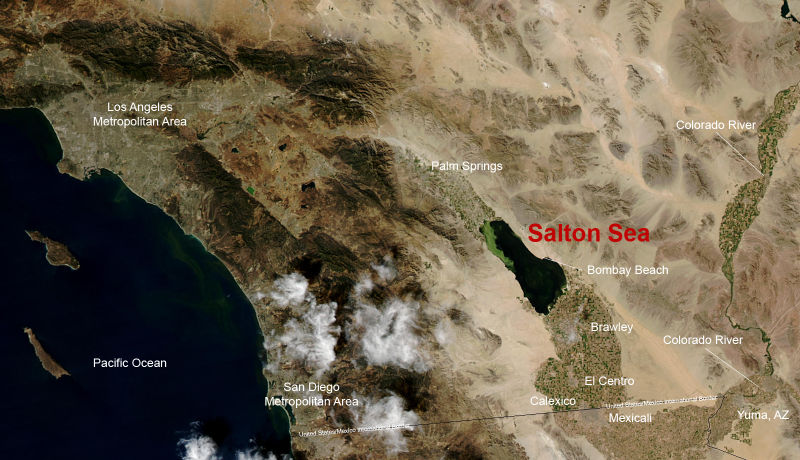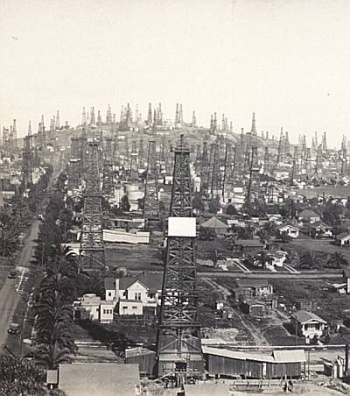Destruction of Los Angeles: Difference between revisions
No edit summary |
No edit summary |
||
| Line 79: | Line 79: | ||
|- | |- | ||
|} | |} | ||
<div style="border-bottom:1px #B87333 solid; text-align:center; font-size:140%; padding:1px; margin:1px;">The Honeycomb and the Sandbar</div> | |||
[[Image:Signal Hill.jpg|350px|thumb|Signal Hill, May 1, 1923: Oil extraction honeycombing the oilsands]] | |||
Los Angeles is one of the largest cities in the world. It is also one of the only cities in the world with significant active oil extraction within city limits. The sediment in the Los Angeles basin is up to 6 miles (10 km) deep, and includes the following oil fields: | |||
*Long Beach Oil Field | |||
*Los Angeles City Oil Field | |||
*Wilmington Oil Field (3rd largest oil field in the U.S.) | |||
*Huntington Beach Oil Field | |||
*Torrance Oil Field | |||
*Beverly Hills Oil Field | |||
Combined with the danger of existing fault lines that Los Angeles sits on, the potential for a devestating natural disaster is scientifically plausible. | |||
Time Magazine[http://www.time.com/time/magazine/article/0,9171,867597,00.html] recorded the partial sinking of Long Beach in the 1950s, blaming the cause on excessive drilling in the area. Since that time, oil producers have been pumping water into the earth to replace the oil they extract. The only problem with this process is that water has different properties than oil, as residents of Daisetta, Texas learned in 2008 when the walls of an underground salt-cave (from which oil brine had been extracted) disolved, creating a sink-hole 900 feet wide by 260 feet deep.[http://www.foxnews.com/story/0,2933,354501,00.html] Between 1932 and 1960 iodine was harvested from oil brine extracted in the Los Angeles basin - raising the question of whether the water being pumped into the earth is currently disolving structural minarals under Los Angeles. | |||
One problem with subsistence (the sinking of land) is that it can create megatsunamis if they occur near water. History records the following megatsunamis created by landslides: | |||
*365 AD - 100ft waves hit Alexandria after an earthquake off Crete. | |||
*1792 AD - 330ft waves killed 15,000 villagers when parts of Mount Unzen, Japan slid into the sea. | |||
*1958 AD - 1,720ft waves destroyed Lituya Bay, Alaska, after an earthquake caused a landslide. | |||
Revision as of 19:18, 10 April 2010
William Branham had just finished preaching a series of meetings in Los Angeles in April 1965, when he was asked by the Full Gospel Business Men who organized the meetings to preach just one more service for them. So, on April 29, William Branham stood behind the podium at the Biltmore Hotel in Los Angeles, and preached a sermon called "Choosing of a Bride". Two notable things occurred during this service:
The Prophecy
Recent Significant L.A. Earthquakes
The Honeycomb and the Sandbar
Los Angeles is one of the largest cities in the world. It is also one of the only cities in the world with significant active oil extraction within city limits. The sediment in the Los Angeles basin is up to 6 miles (10 km) deep, and includes the following oil fields:
Combined with the danger of existing fault lines that Los Angeles sits on, the potential for a devestating natural disaster is scientifically plausible. Time Magazine[1] recorded the partial sinking of Long Beach in the 1950s, blaming the cause on excessive drilling in the area. Since that time, oil producers have been pumping water into the earth to replace the oil they extract. The only problem with this process is that water has different properties than oil, as residents of Daisetta, Texas learned in 2008 when the walls of an underground salt-cave (from which oil brine had been extracted) disolved, creating a sink-hole 900 feet wide by 260 feet deep.[2] Between 1932 and 1960 iodine was harvested from oil brine extracted in the Los Angeles basin - raising the question of whether the water being pumped into the earth is currently disolving structural minarals under Los Angeles. One problem with subsistence (the sinking of land) is that it can create megatsunamis if they occur near water. History records the following megatsunamis created by landslides:
|



